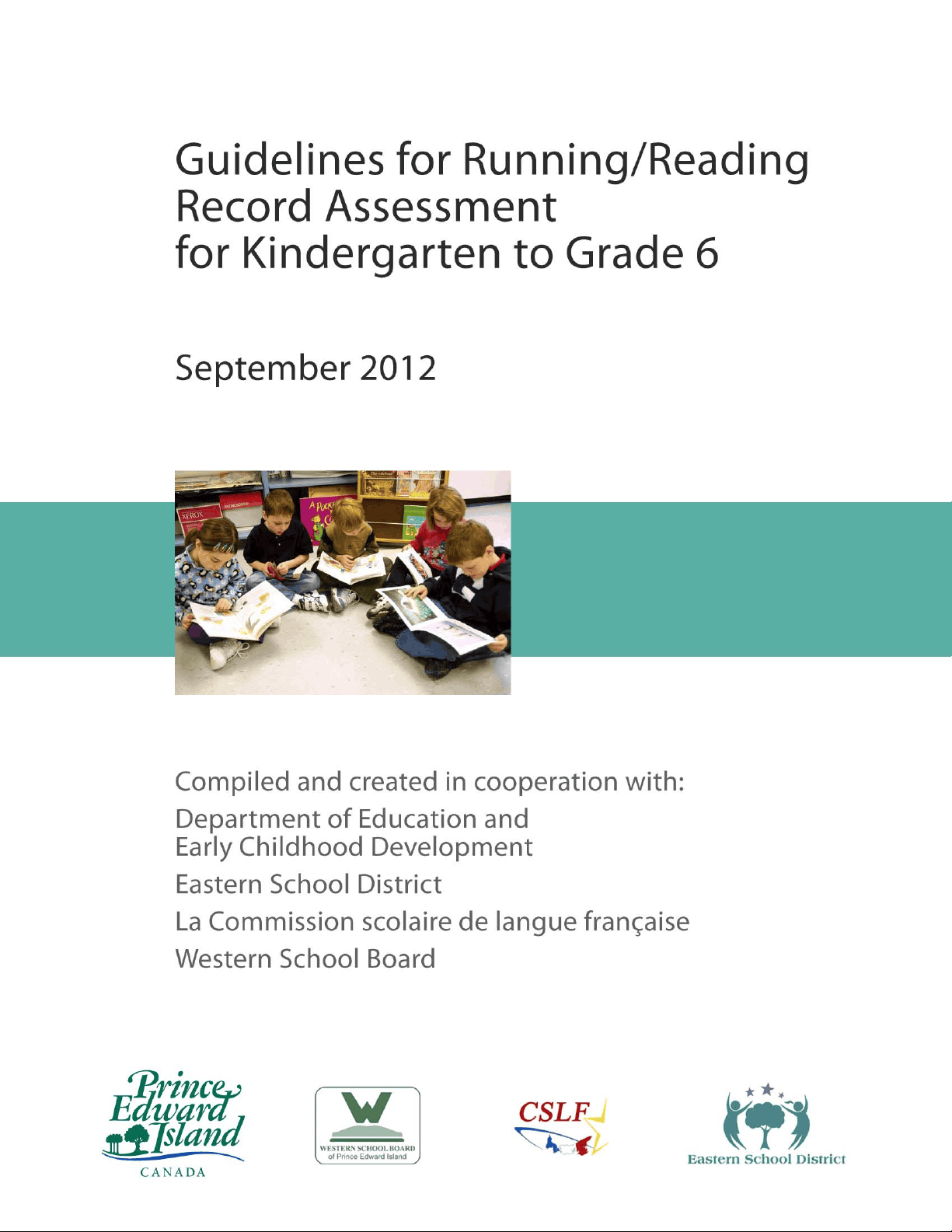
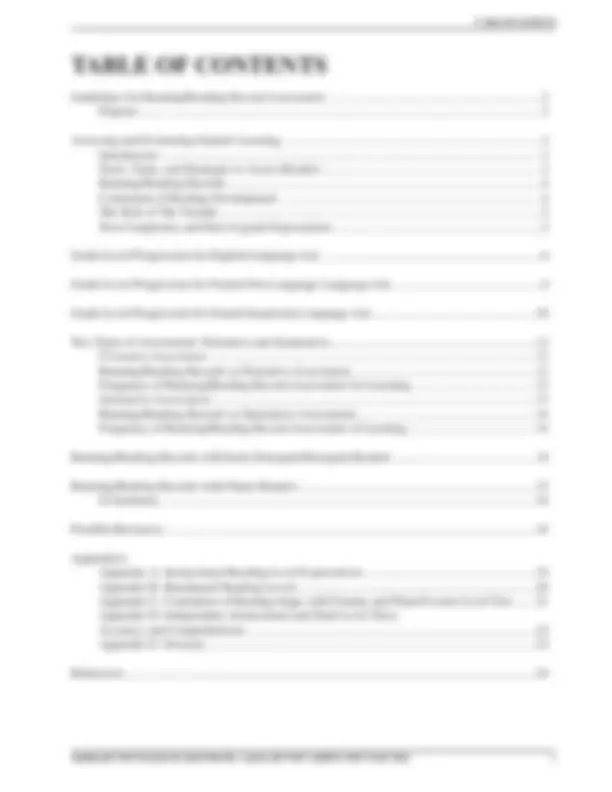

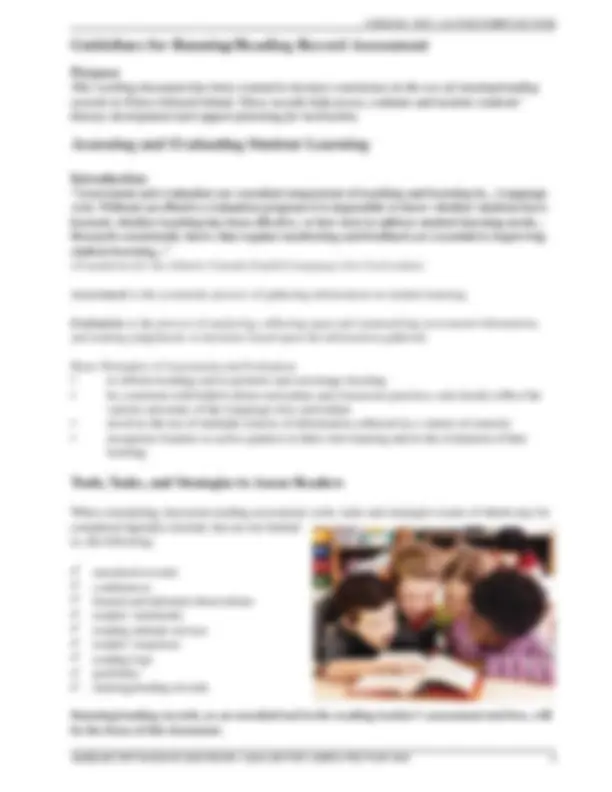
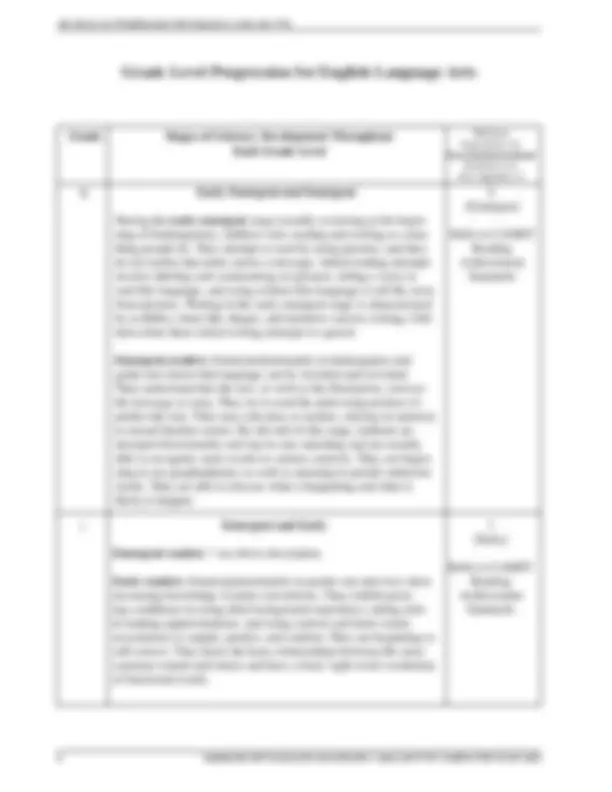
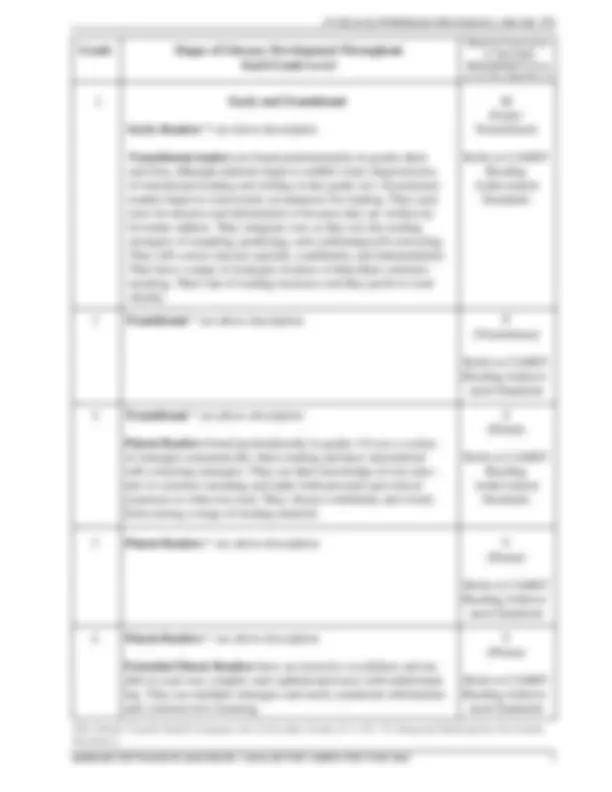
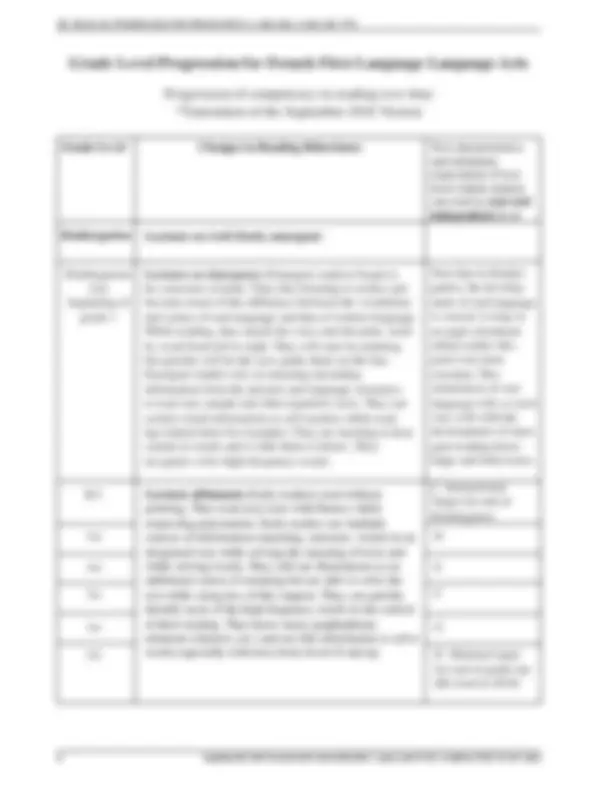
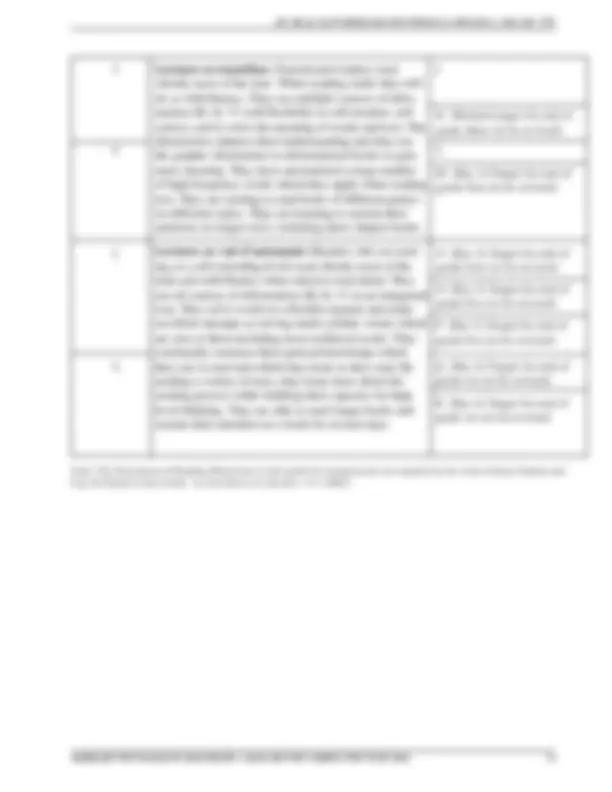
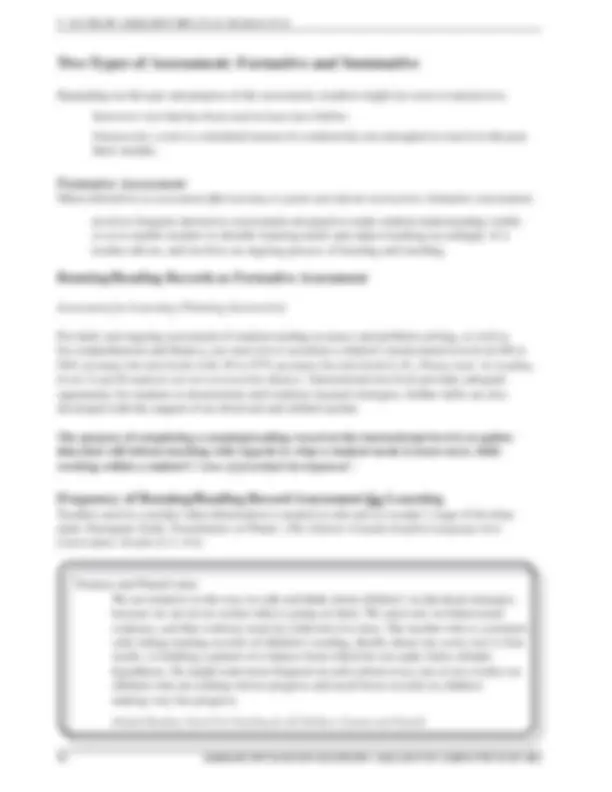
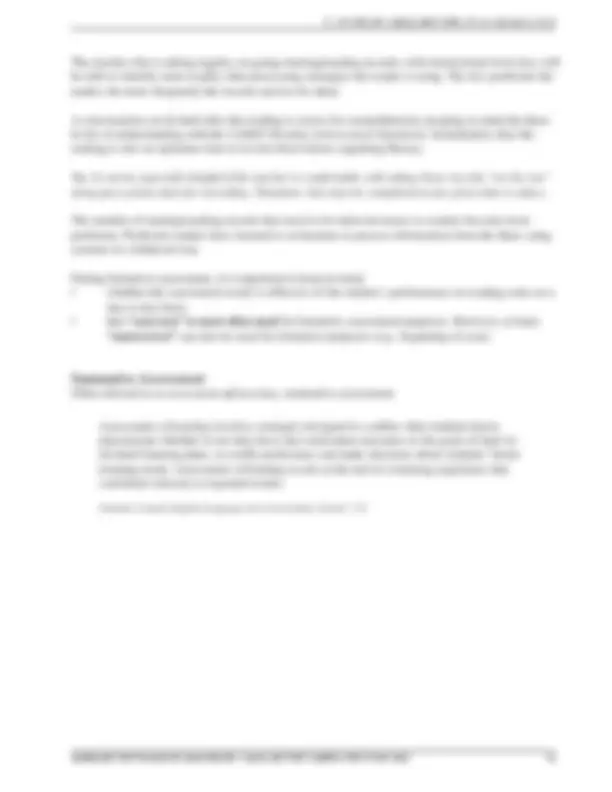
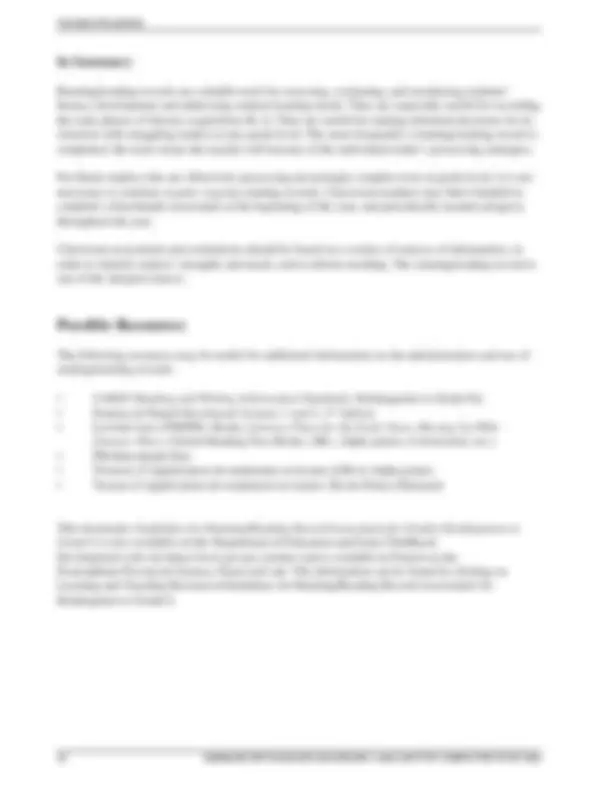
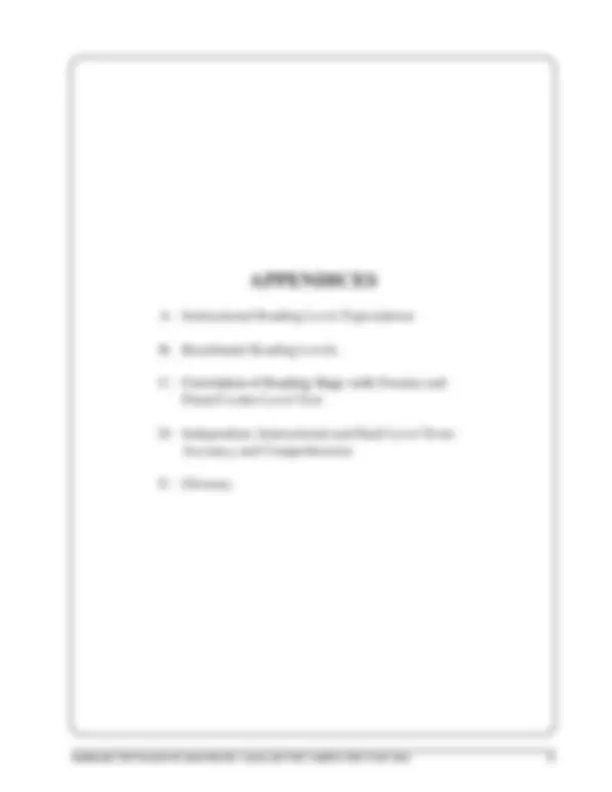

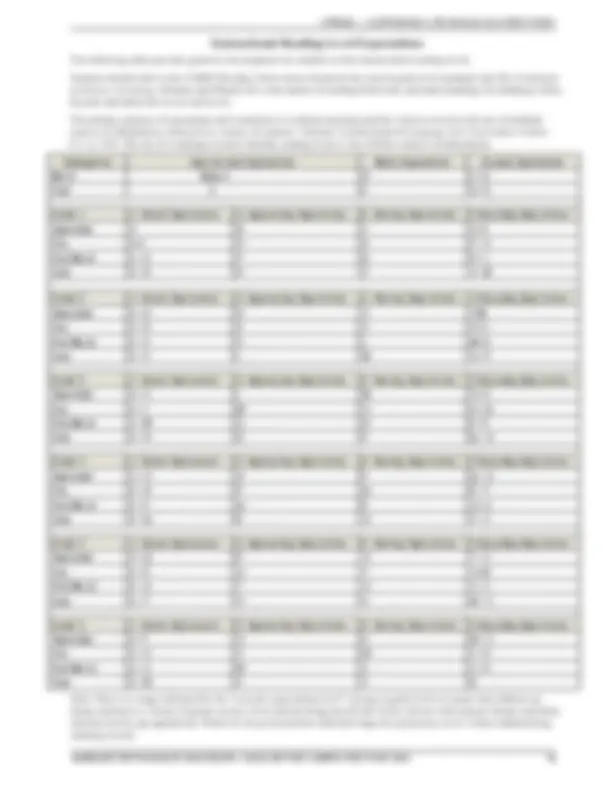
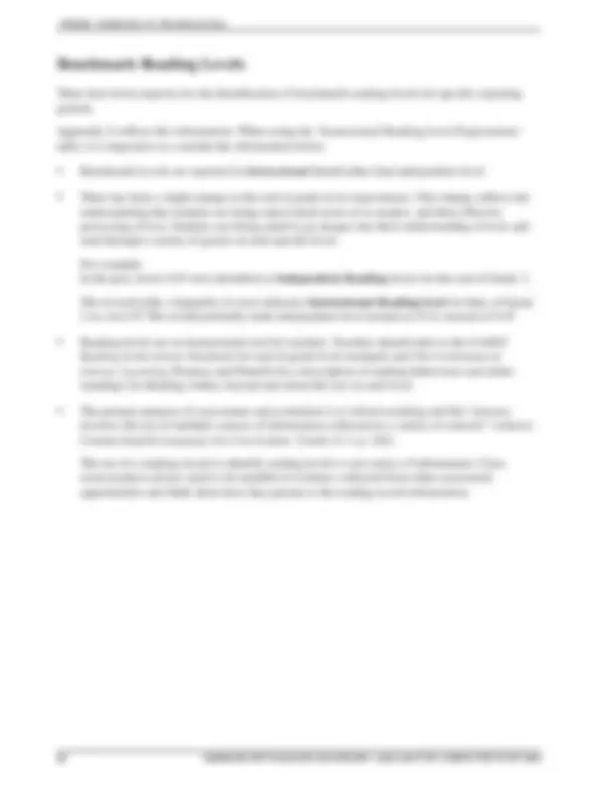
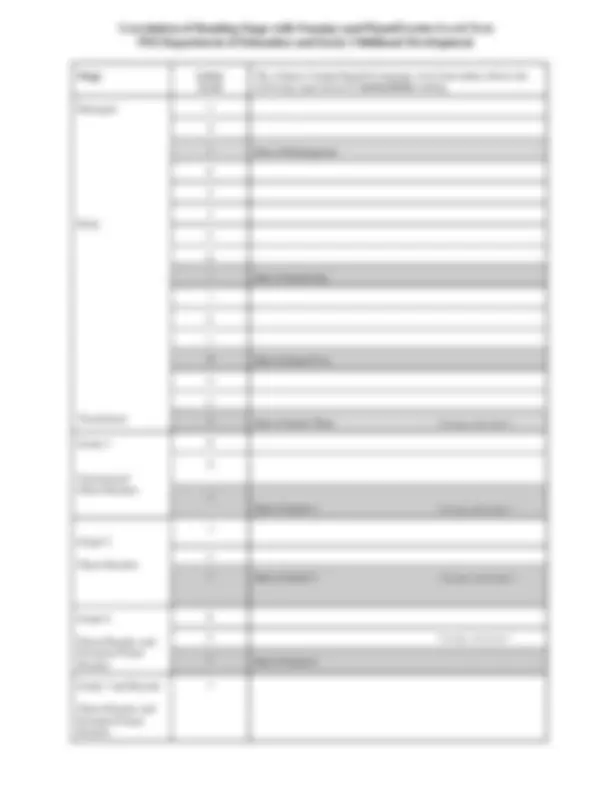
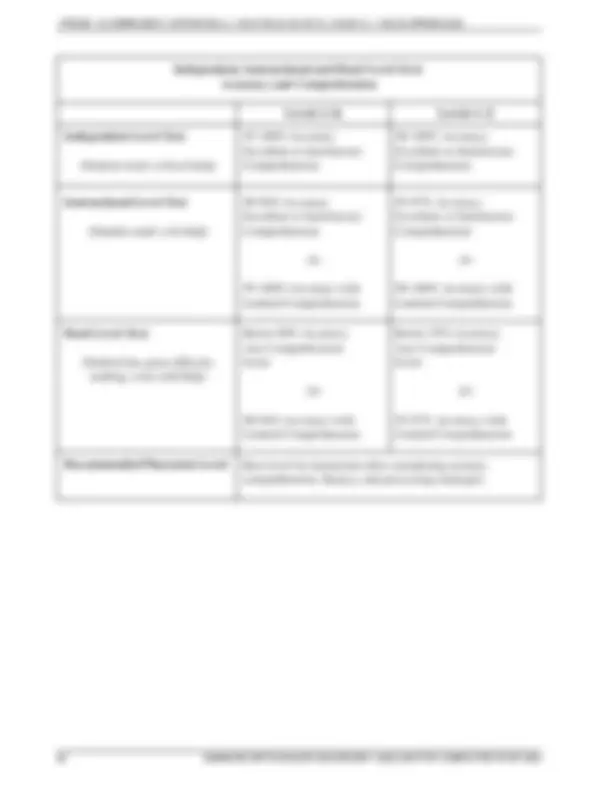
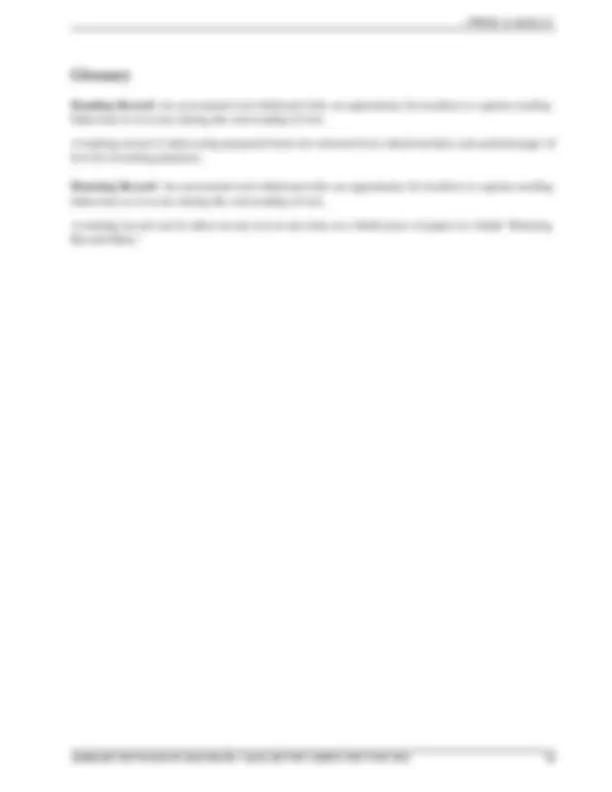
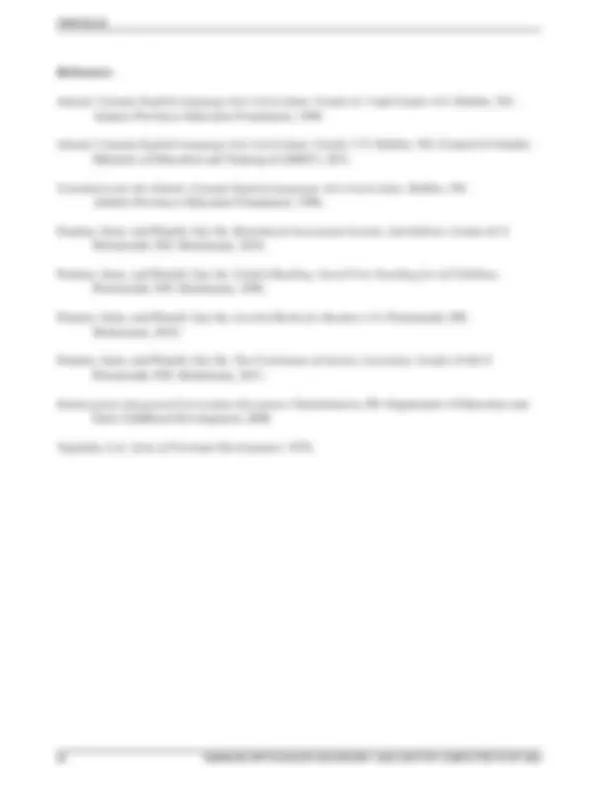


Study with the several resources on Docsity

Earn points by helping other students or get them with a premium plan


Prepare for your exams
Study with the several resources on Docsity

Earn points to download
Earn points by helping other students or get them with a premium plan
Community
Ask the community for help and clear up your study doubts
Discover the best universities in your country according to Docsity users
Free resources
Download our free guides on studying techniques, anxiety management strategies, and thesis advice from Docsity tutors
These records help assess, evaluate and monitor students' literacy development and support planning for instruction. Page 6. 4. GUIDELINES FOR RUNNING/READING ...
Typology: Study notes
1 / 26

This page cannot be seen from the preview
Don't miss anything!



















“Assessment and evaluation are essential components of teaching and learning in... Language Arts. Without an effective evaluation program it is impossible to know whether students have learned, whether teaching has been effective, or how best to address student learning needs... Research consistently shows that regular monitoring and feedback are essential to improving student learning...” (Foundation for the Atlantic Canada English Language Arts Curriculum)
Assessment is the systematic process of gathering information on student learning.
Evaluation is the process of analyzing, refl ecting upon and summarizing assessment information, and making judgements or decisions based upon the information gathered.
Basic Principles of Assessment and Evaluation
When considering classroom reading assessment, tools, tasks and strategies (some of which may be completed digitally) include, but are not limited to, the following:
(^) anecdotal records (^) conferences (^) formal and informal observations (^) readers’ notebooks (^) reading attitude surveys (^) readers’ responses (^) reading logs
(^) portfolios (^) running/reading records
Running/reading records, as an essential tool in the reading teacher’s assessment tool box, will be the focus of this document.
This working document has been created to increase consistency in the use of running/reading records in Prince Edward Island. These records help assess, evaluate and monitor students’ literacy development and support planning for instruction.
A teacher’s goal is to support students as they develop their reading skills on increasingly difficult text. To achieve this goal, teachers need to:
Students’ literacy development is enhanced with teachers understand the continuum of reading development, and select texts that correspond with the student’s zone of proximal development. It may be helpful to consider the following guidelines: (Please note that there are differences in the terms used in Francophone and Immersion classrooms)
Running/reading records provide information to plan focused reading instruction and to select books at an appropriate difficulty level. The following tables provide descriptions of grade level progressions in reading development for English, French, and French Immersion students on Prince Edward Island.
It must be emphasized however, that this process of literacy development is not lockstep or linear. The rate of progress varies for each child. The goal is to accept children where they are and provide opportunities for them to build on their understanding. Through ongoing and meaningful assessment, educators become aware of the child’s stage of literacy development.
GUIDELINES FOR RUNNING/READING RECORD ASSESSMENT
(Early)
Refer to CAMET Reading Achievement Standards
Grade Stages of Literacy Development Throughout Each Grade Level
Minimum Expectations for Year-End Instructional Reading Level (See Appendix A)
1 Emergent and Early
Emergent readers * see above description.
Early readers (found predominantly in grades one and two) show increasing knowledge of print conventions. They exhibit grow- ing confidence in using their background experience, taking risks in making approximations, and using context and letter sound associations to sample, predict, and confi rm. They are beginning to self-correct. They know the basic relationships between the most common sounds and letters and have a basic sight word vocabulary of functional words.
(Emergent)
Refer to CAMET Reading Achievement Standards
K Early Emergent and Emergent
During the early emergent stage (usually occurring at the begin- ning of kindergarten), children view reading and writing as some- thing people do. They attempt to read by using pictures, and they do not realize that print carries a message. Initial reading attempts involve labeling and commenting on pictures, telling a story in oral-like language, and using written-like language to tell the story from pictures. Writing in the early emergent stage is characterized by scribbles, letter-like shapes, and imitative cursive writing. Chil- dren relate these initial writing attempts to speech.
Emergent readers (found predominantly in kindergarten and grade one) know that language can be recorded and revisited. They understand that the text, as well as the illustration, conveys the message or story. They try to read the print using pictures to predict the text. They may role-play as readers, relying on memory to reread familiar stories. By the end of this stage, students un- derstand directionality and one-to-one matching and are usually able to recognize some words in various contexts. They are begin- ning to use graphophonics as well as meaning to predict unknown words. They are able to discuss what is happening and what is likely to happen.
GRADE LEVEL PROGRESSION FOR ENGLISH LANGUAGE ARTS
Grade Level Changes in Reading Behaviours Text characteristics and minimum expectation of text level which student can read at year-end independent level
Kindergarten/ very beginning of grade 1
Lecteurs en émergence (Emergent readers) begin to be conscious of print. They like listening to stories and become aware of the difference between the vocabulary and syntax of oral language and that of written language. While reading, they match the voice and the print, word by word from left to right. They will start by pointing but quickly will let the eyes guide them on the line. Emergent readers rely on meaning (including information from the picture) and language structures to read very simple and often repetitive texts. They use certain visual information to self monitor while read- ing (initial letter for example). They are learning to hear sounds in words and to link them to letters. They recognize a few high-frequency words.
Note that in Kinder- garten, the develop- ment of oral language is crucial. Living in an anglo-dominant milieu makes this goal even more essential. This stimulation of oral language will co-exist very well with the development of emer- gent reading know- ledge and behaviours.
Lecteurs débutants (Early readers) read without pointing. They read easy texts with fl uency while respecting punctuation. Early readers use multiple sources of information (meaning, structure, visual) in an integrated way while solving the meaning of texts and while solving words. They still use illustrations as an additional source of meaning but are able to solve the text while using less of this support. They can quickly identify most of the high frequency words in the context of their reading. They know many graphophonic elements (clusters, etc.) and use this information to solve words especially with texts from levels E and up.
1re
1re
1re
1re
1re
C Instructional Target for end of Kindergarten D
H Minimal target for end of grade one (Revised in 2010)
Kindergarten (^) Lecteurs en éveil (Early emergent)
GRADE LEVEL PROGRESSION FOR FRENCH FIRST LANGUAGE LANGUAGE ARTS
3e
3e/4e
3e/4e
4e
4e/5e
1re/2e
1re/2e
2e
2e
2e/3e
I Target for end of grade one (Revised in 2010)
J
L Minimal target for end of grade two (Revised in 2010)
M Minimal target for end of grade three (Revised in 2010)
Lecteurs en transition (Transitional readers) read silently most of the time. When reading orally they will do so with fluency. They use multiple sources of information (M, St, V) with fl exibility to self- monitor, self-correct and to solve the meaning of words and text. The illustrations enhance their understanding and they use the graphic information in informational books to gain more meaning. They have automatized a large number of high frequency words which they apply when reading text. They are starting to read books of different genres on different topics. They are learning to sustain their attention on longer texts, including short chapter books.
Lecteurs en voie d’autonomie (Readers who are reading at a self-extending level) read silently most of the time and with fl uency when asked to read aloud. They use all sources of information (M, St, V) in an integrated way. They solve words in a flexible manner and make excellent attempts at solving multi-syllabic words which are new to them including more technical words. They continually construct their general knowledge which they use to read and which they learn as they read. By reading a variety of texts, they learn more about the reading process while building their capacity for high level thinking. They are able to read longer books and sus- tain their attention on a book for several days.
N Target for end of grade three (Revised in 2010)
O Minimal target for end of grade four (Revision 2010 - draft to continue to be revised) P Target for end of grade four (Revision 2010 - draft to continue to be revised)
R Target for end of grade fi ve (Revision 2010 - draft to continue to be revised)
Q Minimal target for end of grade fi ve (Revision 2010
(Note: The Description of Reading Behaviours in this grade level progression was inspired by the work of Irene Fountas and Gay Su Pinnell in their book ‘ Leveled Books for Readers 3-6 ’ (2002), as well as the observations of our readers.)
6e Lecteurs avancés R et R+ Target for end of grade six (Revision 2010
3 Lecteurs en transition (Transitional readers) read silently most of the time. When reading orally they will do so with fl uency. They use multiple sources of infor- mation (M, St, V) with fl exibility to self-monitor, self- correct, and to solve the meaning of words and text. The illustrations enhance their understanding and they use the graphic information in informational books to gain more meaning. They have automatized a large number of high frequency words which they apply when reading text. They are starting to read books of different genres on different topics. They are learning to sustain their attention on longer texts, including short chapter books.
K Minimal target for end of grade three (to be revised) L
M (Bac 4) Target for end of grade four (to be revised)
Lecteurs en voie d’autonomie (Readers who are read- ing at a self-extending level) read silently most of the time and with fluency when asked to read aloud. They use all sources of information (M, St, V) in an integrated way. They solve words in a fl exible manner and make excellent attempts at solving multi-syllabic words which are new to them including more technical words. They continually construct their general knowledge which they use to read and which they learn as they read. By reading a variety of texts, they learn more about the reading process while building their capacity for high level thinking. They are able to read longer books and sustain their attention on a book for several days.
N (Bac 4) Target for end of grade four (to be revised)
Q (Bac 6) Target for end of grade six (to be revised)
O (Bac 5) Target for end of grade five (to be revised)
P (Bac 5) Target for end of grade five (to be revised)
R (Bac 6) Target for end of grade six (to be revised)
Note: The Description of Reading Bahaviours in this grade level progression was inspired by the work of Irene Fountas and Gay Su Pinnell in their book, ‘Leveled Books for Readers 3-6’ (2002).
Assessment for Learning (Planning Instruction)
For daily and ongoing assessment of student reading accuracy and problem solving, as well as for comprehension and fluency, use seen text to ascertain a student’s instructional text level (90 to 94% accuracy for text levels A-K; 95 to 97% accuracy for text levels L-Z). Please note: At reading levels A and B students are not assessed for fl uency. Instructional text level provides adequate opportunity for students to demonstrate and reinforce learned strategies; further skills are also developed with the support of an observant and skilled teacher.
The purpose of completing a running/reading record at the instructional level is to gather data that will inform teaching with regards to what a student needs to learn next, while working within a student’s ‘ zone of proximal development’****.
Teachers need to consider what information is needed or relevant at a reader’s stage of develop- ment: Emergent, Early, Transitional, or Fluent. (The Atlantic Canada English Language Arts Curriculum: Grades E-3, 4-6).
Depending on the type and purpose of the assessment, teachers might use seen or unseen text.
Seen text: text that has been read at least once before. Unseen text: a text is considered unseen if a student has not attempted to read it in the past three months.
Often referred to as assessment for learning to guide and inform instruction, formative assessment:
involves frequent interactive assessments designed to make student understanding visible so as to enable teachers to identify learning needs and adjust teaching accordingly. It is teacher-driven, and involves an ongoing process of learning and teaching.
Fountas and Pinnell state: We are tentative in the way we talk and think about children’s in-the-head strategies because we are never certain what is going on there. We must rely on behavioural evidence, and that evidence must be collected over time. The teacher who is systemati- cally taking running records of children’s reading, ideally about one every two to four weeks, is building a pattern of evidence from which he can make fairly reliable hypotheses. He might want more frequent records (about every one or two weeks) on children who are making slower progress and need fewer records on children making very fast progress. (Guided Reading: Good First Teaching for All Children, Fountas and Pinnell)
TWO TYPES OF ASSESSMENT: FORMATIVE AND SUMMATIVE
During summative assessment, it is important to keep in mind:
Early emergent/emergent readers are found predominately in kindergarten.
The following bullets describe the characteristics of an ‘emergent’ reader. When a child is observed displaying a cluster (or several) of these, the teacher could begin to take running records of text reading to capture reading behaviours and inform further instruction:
Assessment of Learning (i.e., year-end assessment)
For the purpose of providing a “snapshot” of how the child is working on text at a specific time, teachers want to identify a text that the student is able to read independently/easily (95 to 100% accuracy for text levels A-K; 98 to 100% accuracy for text levels L-Z) with appropriate fluency and comprehension.
For consistency, the protocol for identifying the student’s independent level requires the use of an unseen text and adherence to the guidelines of the assessment tool.
TWO TYPES OF ASSESSMENT: FORMATIVE AND SUMMATIVE
Generally teachers in the primary grades take formal [summative] running records about three times during the year. They do not spend time on extensive analysis with those students who are growing steadily and processing print effectively for their stage of development. Other students will require an in-depth analysis, and more frequent informal checks.
(Atlantic Canada English Language Arts Curriculum: Grades E-3, p. 250)
Fluent readers are found predominantly in the upper elementary grades (see page 7).
Students who are reading at the fl uent stage of development are effectively integrating processing systems, therefore the need for taking running/reading records decreases.
Older, proficient readers read fast and do much of their word solving and self-correcting automati- cally. The proficient reader is able to solve words quickly, silently and “on the run” (while reading). They can correct errors before saying them, which leaves the teacher with little or no evidence of the reader’s processing. Consequently, the relevance of the running/reading record information may diminish.
However, teachers in the upper elementary grades may fi nd it helpful to complete a benchmark reading record assessment at the beginning of the year to assess text diffi culty and inform instruc- tional groupings for guided reading. They may also use this form of assessment to monitor progress periodically throughout the year. The teacher needs to capitalize on additional opportunities to listen to the students read orally and engage in “comprehension conversations” within various teaching contexts throughout the day (guided reading, conferences).
Students who experience difficulty with processing the sources of information and have not entered the fl uent stage of reading development, need explicit instruction, and running/reading records can be a key source of information for such teaching. By regularly completing formative running/read- ing record assessments on a struggling reader, a teacher may be able to examine more closely the reading behaviours of the child and look for patterns over time, using this information to guide their instruction.
APPENDICES